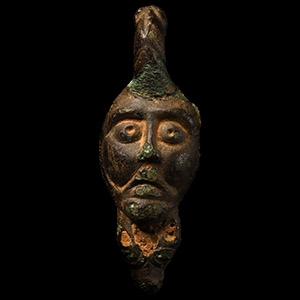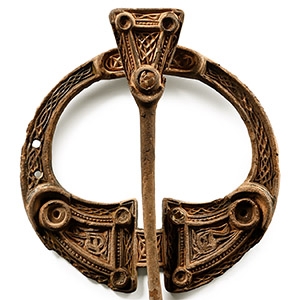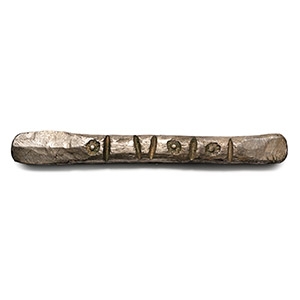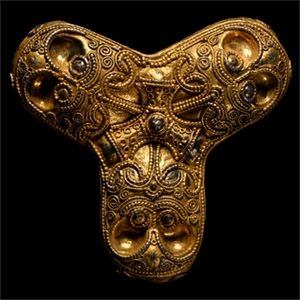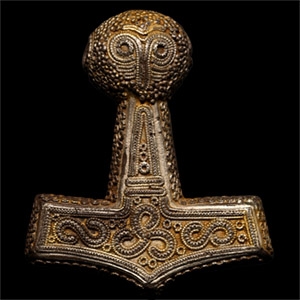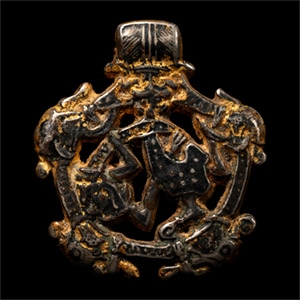Home > Auctions > 3 - 11 June 2025
Ancient Art, Antiquities, Books, Natural History & Coins
Found Colchester, Essex, UK, 1990s.
This lot is accompanied by an illustrated lot declaration signed by the Head of the Antiquities Department, Dr Raffaele D'Amato.
Cf. Jope, E. M., Early Celtic Art, Oxford, 2000, pl.302-3, described as a vehicle pole and yoke fittings; Macdonald, P., Llyn Cerrig Bach. A Study of the Copper Alloy Artefacts from the Insular La Tène Assemblage, Cardiff, 2007, fig.23, item 49; cf. similar offered in Christie's, London, 12 December 1984, no.26A (£7,000-£10,000).
Twenty or so 'horn caps' are known in museums and private collections, all have been found in Britain and mostly in Southern England. This type of decorative cap is from the end of a curved wooden handle which projected from the back of an Iron Age chariot, by which a warrior could pull himself back into the chariot. The chariot to which this would have been attached would have belonged to a chief or wealthy warrior from the Icenic tribe.
Found whilst searching with a metal detector in Middle Aston, Cherwell, Oxfordshire, UK, on Wednesday 1st May 2024.
Accompanied by a copy of the British Museum's Portable Antiquities Scheme (PAS) report no.OXON-B4DF83.
This lot has been cleared against the Art Loss Register database, and is accompanied by an illustrated lot declaration signed by the Head of the Antiquities Department, Dr Raffaele D'Amato.
Cf. Hammond, Brett, British Artefacts Volume 1 - Early Anglo-Saxon, 2009, p.55, fig,1.1.6.6-h & i; cf. pair of saucer brooches from Berinsfield in MacGregor, A. & Bolick, E., A Summary Catalogue of the Anglo-Saxon Collections (Non-Ferrous Metals), item 2.43; and Dickinson, T., Early Saxon Saucer Brooches: A Preliminary Overview' Anglo-Saxon Studies in Archaeology and History, 1993, 6 pp.11-44.
Saucer brooches are a female Saxon fashion, contemporary with the Anglian penannular and cruciform types, normally worn at the shoulders to secure a tubular dress.
Private collection formed in Europe in the 1980s.
Westminster collection, central London, UK.
This lot has been cleared against the Art Loss Register database, and is accompanied by an illustrated lot declaration signed by the Head of the Antiquities Department, Dr Raffaele D'Amato.
Cf. Beck, H. et al., Fibel und Fibeltracht, Berlin, 2000, item 468; similar brooches from the Frankish cemetery at Monceau-le-Neuf-et-Faucouzy, deptn Aisne, France in Menghin, W., The Merovingian Period. Europe Without Borders, item VII.23.2; and the S-fibula from Schwarz-Rheindorf, Westphalia, in Menghin, W., The Merovingian Period. Europe Without Borders, item VII.48.27.
During the mid-sixth century the S-brooch, along with the disc brooch, became popular. These were made primarily of gilded silver embellished with garnet inlays or in garnet cloisonné. Early forms of S-shaped brooches appear in graves in Scandinavia throughout the fifth century and in Europe during the first decades of the sixth century, and reached the height of their popularity during the latter half of that time. They were widespread across Europe and are found in central and western Europe, Italy, Scandinavia and Anglo-Saxon England. They generally take the form of an S-shaped body with heads at either end facing in opposite directions. The heads are generally depicted as birds but examples are known of unidentified animals with splayed open jaws, possibly dragons or wolves. The use of the head imagery is consistent with the aesthetic tendencies associated with the northern, Pagan Germanic world.
Found Sutton Fields, Sutton on the Forest, Yorkshire, UK, on 21 November 1999.
From the private collection of Robin Sykes, Yorkshire, UK, formed since the late 1990s.
Accompanied by an illustrated record sheet by Jim Halliday dated 22 November 1999, and various off-prints.
This lot is accompanied by an illustrated lot declaration signed by the Head of the Antiquities Department, Dr Raffaele D'Amato.
Cf. Williams, D., Late Saxon Stirrup-Strap Mounts. A Classification and catalogue, 1997, pp.36-39, figs.74-78.
Found Sutton Fields, Sutton on the Forest, Yorkshire, UK, on 27 May 2005.
From the private collection of Robin Sykes, Yorkshire, UK, formed since the late 1990s.
Accompanied by an illustrated record card by Jim Halliday incorrectly identified as Romano-Celtic.
This lot is accompanied by an illustrated lot declaration signed by the Head of the Antiquities Department, Dr Raffaele D'Amato.
Cf. the Arnside Mount in the collection of Kendal Museum for similar human mask on a bowl mount; similar item in the British Museum under accession no.1992,0502.1.
Found by Mr Steven Thomas whilst searching with a metal detector in Powys, Wales, UK, on 28th July 2023.
Accompanied by a copy of the Cymru Portable Antiquities Scheme (PAS) report no.SN 91399 13122; NMGW-67571D.
Accompanied by a condition report and analysis, no.012501 by the Nation Museum of Cardiff.
This lot has been checked against the Interpol Database of stolen works of art and is accompanied by a search certificate number no.12730-236283.
This lot has been cleared against the Art Loss Register database, and is accompanied by an illustrated lot declaration signed by the Head of the Antiquities Department, Dr Raffaele D'Amato.
Cf. Youngs, S. (ed.), The Work of Angels. Masterpieces of Celtic Metalwork, 6th-9th centuries AD, London, 1989, for general treatment of Insular metalwork; Stevenson, R.B.K., The Hunterston Brooch and its Significance, Medieval Archaeology vol.18, 1974; Redknap, M., Insular Non-Ferrous Metalwork from wales of the 8th to 10th Centuries, in Bourke, C. (ed.), From the Isles of the North. Early Medieval Art in Ireland and Britain, Belfast, 1995; Rynne, E., Gilt Bronze Brooch from Near Kilshanny, Co.Clare, in North Munster Antiquarian Journal, vol.30, 1988.
The brooch is 'pseudo-penannular' because of the apparent gap between the flared terminals is blocked by the small rectangular panel; thus the pin cannot pass between the flared ends in the normal manner of a penannular brooch, where one of the curved arms is passed behind the pin to lock it in place. The findspot lies close to a major highway running from the kingdom of Brycheiniog to the southern part of Wales, not far from the Maen Madoc inscribed stone.
Private collection formed in Europe in the 1980s.
Westminster collection, central London, UK.
This lot has been cleared against the Art Loss Register database, and is accompanied by an illustrated lot declaration signed by the Head of the Antiquities Department, Dr Raffaele D'Amato.
See Graham-Campbell, J. & Philpott, R., The Huxley Viking Hoard - Scandinavian Settlement in the North West, Liverpool, 2009, for discussion.
From the private collection of a London gentleman, from his grandfather's collection formed before the early 1970s.
This lot is accompanied by an illustrated lot declaration signed by the Head of the Antiquities Department, Dr Raffaele D'Amato.
See Graham-Campbell, J & Philpott, R., The Huxley Viking Hoard - Scandinavian Settlement in the North West, Liverpool, 2009, for discussion of hoarding and silver production at this time.
From the private collection of a London gentleman, from his grandfather's collection formed before the early 1970s.
This lot is accompanied by an illustrated lot declaration signed by the Head of the Antiquities Department, Dr Raffaele D'Amato.
Private collection formed in Europe in the 1980s.
Westminster collection, central London, UK.
This lot has been checked against the Interpol Database of stolen works of art and is accompanied by a search certificate number no.12734-235601.
This lot has been cleared against the Art Loss Register database, and is accompanied by an illustrated lot declaration signed by the Head of the Antiquities Department, Dr Raffaele D'Amato.
Cf. The British Museum, museum number 1810,1110.3, for a broadly similar example; Beck, H. et al., Fibel und Fibeltracht, Berlin, 2000, p.194-5, for discussion of the type; Ewing, T., Viking Clothing, Stroud, 2007, plate 38; Wilson, D.M. and Klindt-Jensen, O., Viking Art, London, 1968, pl.XXXII; Smith, R.A. British Museum Guide to Anglo-Saxon Antiquities, reprinted Ipswich, 1993, p.160.
The trefoil type is based on a three-armed strap distributor for a sword-belt used by the Carolingian Franks, copied and re-modelled to Scandinavian taste and finally re-purposed as a female dress-ornament or brooch.
Private collection formed in Europe in the 1980s.
Westminster collection, central London, UK.
This lot has been checked against the Interpol Database of stolen works of art and is accompanied by a search certificate number no.12735-235602.
This lot has been cleared against the Art Loss Register database, and is accompanied by an illustrated lot declaration signed by the Head of the Antiquities Department, Dr Raffaele D'Amato.
See similar examples with applied decoration found in Sweden (Kabbara, Bredsatra, Odeshok); and Hilderbrand, H., The Industrial Arts of Scandinavia in the Pagan Time, London, 1883, p.113, fig.99 and Arbman, H., Birka, Taf. 83, item 1a; for a discussion on Thor pendanrs and further examples, cf. Exhibition Catalogue, Les Vikings, Les Scandinaves et L'Europe 800-1200, Paris, 1992, p.190 & 276.
Private collection formed in Europe in the 1980s.
Westminster collection, central London, UK.
This lot has been cleared against the Art Loss Register database, and is accompanied by an illustrated lot declaration signed by the Head of the Antiquities Department, Dr Raffaele D'Amato.
Cf. Korshyn, V.E., Yazicheskiye Priveski Drevniye Rusi X-XIV Vekov, Moscow, 2013, items K.2.01-03
There is a class of discoid pendants with banded borders and contorted figures found in the hinterland of the Baltic region, associated with the influence of Scandinavian settlers. The design of these items recalls specific elements of Scandinavian art - for example, the 'gripping hands' motif is a feature of the Oseberg Style named after the famous Norwegian ship-burial. Oseberg Style is associated with the beginnings of the Viking age, and was current in the 9th century when Scandinavian settlers began to establish centres of trade and political control in the area of the rivers Dnieper and Volga. The motif has been interpreted as a horse and linked with various legends and mythic figures.
193 - 204 of 3130 LOTS

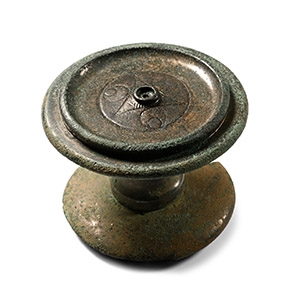
.jpg)
.jpg)

